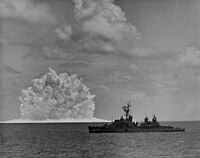Nuclear depth bomb
This article has multiple issues. Please help improve it or discuss these issues on the talk page. (Learn how and when to remove these template messages)
No issues specified. Please specify issues, or remove this template. |

A Nuclear Depth Bomb (NDB) is the nuclear equivalent of the conventional depth charge and can be used in Anti-Submarine Warfare (ASW) for attacking submerged submarines. The British Royal Navy, Soviet Navy and United States Navy had nuclear depth bombs in their arsenals at one point.
Due to the use of a nuclear warhead of much greater explosive power than that of the conventional depth charge, the Nuclear Depth Bomb considerably increases the likelihood (to the point of near certainty) of the destruction of the attacked submarine.
Because of this much greater power some NDBs feature a variable yield, whereby the explosive energy of the device may be varied between a low setting for use in shallow or coastal waters, and a high yield for deep water open-sea use. This is intended to minimize damage to peripheral areas and shipping.
See also
